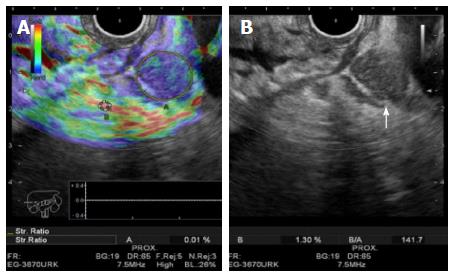Copyright
©The Author(s) 2017.
World J Gastrointest Endosc. Jun 16, 2017; 9(6): 243-254
Published online Jun 16, 2017. doi: 10.4253/wjge.v9.i6.243
Published online Jun 16, 2017. doi: 10.4253/wjge.v9.i6.243
Figure 4 A lymph node being evaluated by elastography, for a gastric tumor staging.
A: Qualitative elastography (color tones red-green-blue) shows the lesion with a blue-predominant color tone, which represents a hard tissue and suggest malignancy. The Strain Ratio (quantitative elastography) is being calculated by compering two different areas (A and B). Area A includes as much of the target lesion as possible. Area B is selected within a soft (red) reference area outside the target lesion. The result (B/A = 141.7) suggests malignancy; B: Shows the round, sharply demarcated and hypoechoic lymph node (white arrow). The endoscopic ultrasound-elastography was done using a Hitachi-Avius console with a radial scope EG-3630URK (from Pentax Medical).
- Citation: Valero M, Robles-Medranda C. Endoscopic ultrasound in oncology: An update of clinical applications in the gastrointestinal tract. World J Gastrointest Endosc 2017; 9(6): 243-254
- URL: https://www.wjgnet.com/1948-5190/full/v9/i6/243.htm
- DOI: https://dx.doi.org/10.4253/wjge.v9.i6.243









